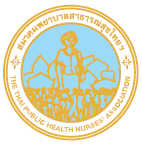Parturient with Eclampsia: Role of Nurses and Midwives in Obstetric Emergency Care
Keywords:
Parturient, Eclampsia, Role of Nurses and Midwives, Obstetric EmergencyAbstract
Eclampsia is a leading cause of health problems among pregnant women which may occur at home, at the hospital before taking magnesium sulfate, and at the hospital after taking magnesium sulfate. Eclampsia may occur after 24 hours after birth. Therefore, the role of nurses and midwives in screening and preventing eclampsia, caring for pregnant women with eclampsia is very important to prevent repeated eclampsia. Nursing care for women during pregnancy, labour, and postpartum periods, including newborns should be planned. Caring for newborns of mothers with eclampsia is also necessary to reduce complications as well as maternal and child mortality.
References
Bureau of Health Promotion, Department of Health, Ministry of Public Health. Analysis of Thai maternal mortality situation for fiscal year 2020 (October 2019–September 2020) from the maternal death surveillance system [Internet]. 2020 [cited 2021 November 13]. Available from: https://hp.anamai.moph.go.th/webupload/4xceb3b571ddb70741ad132d75876bc41d/tinymce/OPDC/OPDC2564-F/IDC1_6/opdc_2564_IDC1-6_01.pdf
Planning Division, Department of Health, Ministry of Public Health. Report on the results of the drive for health promotion and environmental health, Department of Health for the first 6 months of the fiscal year 2021 (October 2020-March 2021) [Internet]. 2021 [cited 2021 November 13]. Available from: https://anamai.moph.go.th/webupload/1xff0d34e409a13ef56eea54c52a291126/filecenter/Download/Annual_report_64.pdf
Kitiyodom S. Eclampsia in Maharat Nakhon Ratchasima Hospital. MJSBH 2014; 29(3): 129-38. (in Thai)
Professional Standards Subcommittee 2019-2021. RTCOG clinical practice guideline management of hypertensive disorders in pregnancy [Internet]. 2021 [cited 2021 November 13]. Available from: http://www.rtcog.or.th/home/wp-content/uploads/2020/10/OB-63-021_Management-of-Hypertensive-Disorders-in-Pregnancy07Oct20.pdf
Samseethong T. Management of epilepsy in pregnancy. Center for Continuing Pharmaceutical Education, Faculty of Pharmaceutical Sciences, Ubon Ratchathani University [Internet]. 2017 [cited 2021 November 13]. Available from: https://ccpe.pharmacycouncil.org/index.phpoption=article_detail&subpage=article_detail&id=284
Cunningham FG, Leneno KJ, Bloom SL, Hauth JC, Rouse DJ, Spong CY. Williams obstetrics. 25th ed. New York: McGraw- Hill; 2018.
Professional Standards Subcommittee 2013-2015. RTCOG clinical practice guideline management of Preeclampsia and Eclampsia [Internet]. 2015 [cited 2021 November 14]. Available from: http://www.rtcog.or.th/home/wp-content/uploads/2020/09/OB-018-.pdf
Sananpanichkul P. Current insight and ideas about preeclampsia. J Prapokklao Hosp Clin Med Educat Center 2015; 32(4): 364-76. (in Thai)
Irene K, Amubuomombe PP, Mogeni R, Andrew C, Mwangi A, Omenge OE. Maternal and perinatal outcomes in women with eclampsia by mode of delivery at Riley mother baby hospital: a longitudinal case-series study. BMC Pregnancy and Childbirth 2021; 21(439): 1-14. Doi: 10.1186/s12884-021-03875-6.
Lertsakornsiri M. Nursing care of pregnant women with complications, revised edition. Bangkok: Assumchan Sueksa Printing House; 2011.
Danpreeda R. Case study of specific patients nursing care of twins pregnancy with severe preeclampsia and caesarean section. JPCN 2018; 1(1): 70-87.
Wongpikul O, Rojananukulpong S, Khamranrit A. Good quality antenatal care should be given before 12 weeks of gestation. Regional Health Promtion Center 9, Nakhonratchasima [Internet]. n.d. [cited 2021 November 16]. Available from: https://hpc9.anamai.moph.go.th/webupload/migrated/files/hpc9/n938_df1afe68b9df03814be919b973140495_article_23017011012160.pdf
Poon LC, Shennan A, Hyett JA, Kapur A, Hadar E, Divakar H, et al. The International Federation of Gynecology and Obstetrics (FIGO) initiative on pre-eclampsia: A pragmatic guide for first-trimester screening and prevention. Int J Gynaecol Obstet 2019; 145 (Suppl 1): 1-33. doi: 10.1002/ijgo.12802.
Liu S, Joseph KS, Liston RM, Bartholomew S, Walker M, Leon JA, et al. Incidence, risk factors, and associated complications of eclampsia. Obstet Gynecol 2011; 118(5): 987-94. doi: 10.1097/AOG.0b013e31823311c1.
Lertbunnaphong T. Maternal weight and pregnancy: factors obstetricians may overlook. Medical records Siriraj 2008; 1(2): 81-90.
Wataganara T. Pregnancy Induced Hypertension. In Wanitpongpan P, Russameecharoen K, Lertbunnaphong T, Editors. Modern textbook of obstetrics. Bangkok: P.A. Living; p. 166-74.
Downloads
Published
How to Cite
Issue
Section
License
บทความที่ตีพิมพ์และแผนภูมิรูปภาพถือเป็นลิขสิทธิ์ของวารสารพยาบาลสาธารณสุข (Thai Public Health Nurses Association)







